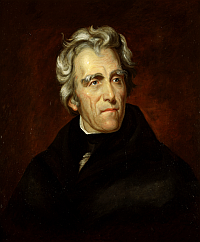Search This Blog
Thursday, January 5, 2012
Andrew Jackson
Served as president from 1829-1837
Era: The Jacksonian Era
American Identity and Culture
During the presidency of Andrew Jackson, many of the common people were on the Jacksonian side. People were very patriotic and very enthusiastic about Jackson being president. The country was also split into a very class-like divide. Through Jackson’s policies and ideals, such as the hatred for the Bank of the United States, he supported the “common people” and claimed for the different treatments of this bank. His ideas split America between the poorer southern and western groups and the northern elitists who had all the wealth in society. The major split between these two groups emphasized the great diversity that is present in the United States.
Economic Transformations and Globalization
Many economic changes occurred during the presidency of Andrew Jackson. One major policy that was passed was the Specie Circular. This policy required all purchases of any federal land to be made in “hard” money, or gold and silver instead of paper money issued by the bank. This soon plunged the nation into the Panic of 1837. Another major issue was the rechartering of the Bank of the United States. The bank, which was going to be expired, was refused a rechartering by President Andrew Jackson. The bank was not issued another charter because of Jackson’s suspicions of the bank being corrupt. Jackson took federal funds and created “pet banks”, state banks that held the federal funds.
Environment
One of the major issues that occurred during Jackson’s presidency was the Indian Removal Act. This act forced Native Americans to be removed and forced westward regardless of whether they were successfully living with the American white people. Andrew Jackson and other white settlers wanted the land that the Native Americans took up and removed them to other unwanted land in the west. The Industrial Revolution and the factory system that was being introduced were now being used and was a very big part of the vast population growth that occurred in the United States.
Politics and Citizenship
During Jackson’s presidency, a nullification crisis occurred where states asserted the belief that they could nullify federal laws they deemed unconstitutional. This was a result of what they called the Tariff of Abominations in 1828. This tariff was passed by Jackson supporters in Congress to increase Northern support in his presidential campaign. South Carolina was hit the hardest due to the opening of new land for cottoning in the southwest. Jackson’s vice president, John Calhoun who came from the state, issued “South Carolina Exposition and Protest” to gain support for nullification. It would declare the federal law void (like it never existed), and refuse to carry out the law. Jackson was against the act of nullification because he saw it as a hindrance to unity within the nation. President Andrew Jackson also used his veto power, more so than any executive before him. An example of his extensive use of veto power was when he vetoed the Maysville Road Bill. This bill planned to provide government funding to build a Kentucky road (which was in the state of his opponent Henry Clay).
Slavery and its legacies in North America
Not all African Americans were slaves during Andrew Jackson’s presidency. A few of them were free; however, that did not stop them from being treated like second-class citizens. A majority of them lived in southern states closer to the north like North Carolina, Virginia, and Maryland. Some slaves managed to buy their freedom from their masters, though this practice was outlawed in the South in the 1830s. There were only a couple of free African Americans who were financially sound, even owning land and slaves of their own, while a majority worked as low-paying laborers. On the other hand, slavery continued to grow in the south. In 1793, Eli Whitney’s invention, the cotton gin, changed the cotton industry and increased the need for slaves.
War and Diplomacy
In 1829, Mexico banned slavery and made all inhabitants convert to the religion of Roman Catholicism, angering the Americans. This developed friction between the two groups, especially because Mexico refused to continue allowing American immigrants into Texas. In 1834, General Santa Anna became Mexico’s dictator and insisted on ruling over Texas. In March 1836, American settlers under Sam Houston rebelled and announced it an independent republic. They were victorious and Santa Anna was forced to sign a treaty that recognized Texas’ independence and granted it territory north of the Rio Grande. Houston, the president of the Republic of Texas, applied for annexation through the U.S. government (being added to the U.S. as a state). However, Jackson put off its request because of opposition from northerners afraid of the expansion of slavery and creation of new slave states from the Texas territories.
Subscribe to:
Post Comments (Atom)

No comments:
Post a Comment